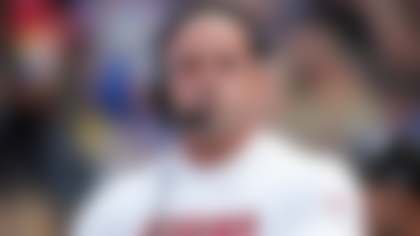INDIANAPOLIS -- Thanks to another strong-looking crop of tackles, offensive line again shapes up as a deep position for the 2010 NFL Draft.
At least five tackles could be selected in the first round, and with so many teams at the top of the draft in need of tackles (Washington Redskins at 4, Kansas City Chiefs at 5, Seattle Seahawks at 6, Oakland Raiders at 8, and Buffalo Bills at 9), as many as four could go in the top 10. In 2009, five tackles were selected within the first 39 picks, including Jason Smith, who went second overall to the St. Louis Rams.
The presumptive star of this year's offensive line class is Russell Okung of Oklahoma State, although based on team needs, he might not come off the board until the fourth or fifth overall pick (the Chiefs are considering moving incumbent LT Branden Albert to guard or right tackle). Okung and the other tackles have a chance to solidify their first-round standing at the NFL Scouting Combine.
Typically, there aren't many interior linemen who figure to be chosen in the early rounds. Perhaps the only potential first-rounder of that group is Idaho's Mike Iupati.
Tight end looks solid, with at least one (Arizona's Rob Gronkowski) potentially going in the first round and a couple of others being drafted within the first two rounds.
The following is a breakdown of the tackles, interior offensive linemen and tight ends widely considered at the top of their positions in the 2010 draft class:
Tackles
**Russell Okung**, Oklahoma State, 6-5, 307
Despite a general lack of polish, his exceptional pass-blocking skills easily put him at the head of this offensive line class. Scouts, who compare Okung favorably with Denver's Ryan Clady, love his quickness and athleticism, both of which allow him to get into favorable position to handle outside rushers. They cite his 36-inch arms and the all-important ability to bend his knees -- giving him good leverage in pass-protection -- as key assets. Okung does need to work on his run-blocking, particularly when it comes to aggressively getting off the ball.
**Bruce Campbell**, Maryland, 6-6, 314
He might very well be the most talented athlete among the offensive linemen. Had it not been for some nagging injuries and inconsistency during his collegiate career, Campbell could be the undisputed best of the crop. He has the necessary footwork to consistently hold his own with faster edge rushers and is helped greatly by 36 ¼-inch arms. The part of his game that scouts say requires the most work is his knee-bend, which could compromise his ability to deal with shorter ends and outside linebackers. But some of that is due to his being a junior and requiring more development.
**Anthony Davis**, Rutgers, 6-5, 323
His steady improvement in college has allowed him to move far enough up the ranks that he should end up being taken in the first round. Questions have been raised about his lack of aggressiveness, but they don't seem serious enough to greatly damage his stock. Davis is an outstanding athlete with considerable strength. Scouts rave about how incredibly quick he is off the ball and the ease with which he is able to engage second-level defenders. As Davis, a junior, matures and develops more consistency, he should emerge as a standout tackle for many years to come.
**Trent Williams**, Oklahoma, 6-5, 315
The first quality about Williams that grabs the attention of scouts is his ability to physically dominate opponents. Aggressiveness is not a problem with this guy, and he's one of the better run-blockers among the tackles. Williams doesn't have the best technique, but he makes up for it with considerable athleticism and power.
**Bryan Bulaga**, Iowa, 6-5, 314
He's a junior, and some scouts think he would have benefitted from another year of collegiate seasoning. But Bulaga is a highly talented athlete, which, along with his size and intelligence, should be good enough for him to receive strong consideration near the bottom of the first round or early in the second.
Interior linemen
**Mike Iupati**, Idaho, 6-5, 331
He has enough size and athletic ability to project as a pretty solid NFL tackle. However, Iupati has the makings of a much better guard, and that would be where any team selecting him -- probably late in the first round -- would have him play. He has an abundance of strength that he consistently utilizes to his advantage in run blocking. He also has good athleticism and quickness, qualities not typically found in guards with his size and strength. And he plays with a nasty streak that should be contagious among his linemates.
**Jon Asamoah**, Illinois, 6-4, 305
He should be the next guard off the board, likely toward the middle of the second round. But there isn't that much of a talent drop from Iupati to Asamoah, who offers enough size, strength, explosiveness, and NFL-readiness to be an immediate starter. His tremendous power allows him to be a dominant force. Asamoah also shows superb techniques that make him solid in pass-protection.
**Maurkice Pouncey**, Florida, 6-4, 304
He is by far the best center in the draft, but probably won't be taken until the third round. Pouncey has good athleticism, and his considerable lower-body strength helps him get good leverage. He also does a nice job of picking up blitzes. However, Pouncey is a junior, and his underdeveloped techniques will keep him from being drafted higher.
**Vlad Ducasse**, UMass, 6-4, 332
He started at left tackle for three years in college after seeing action as a guard in his first season. His wide frame certainly seems to make him a more natural fit at guard in the NFL. Ducasse also has the necessary toughness to play the position well at the next level, even if he is making a fairly big competitive jump. His slow feet -- the reason he doesn't project as a tackle -- could limit his early impact and will probably push him to the third round. But he has a promising future.
**Mitch Petrus**, Arkansas, 6-3, 310
He is among the more intriguing guard prospects because of an eclectic collegiate background that saw him play fullback and tight end before he switched to tackle. In 2008, Petrus was academically ineligible, but he made an impressive comeback last season. He has enough athleticism and to contribute as a rookie, and showcased his strength by setting a new bench press record at the combine.
Tight ends
**Rob Gronkowski**, Arizona, 6-6, 264
He might very well be the most complete tight end in the draft and has a chance to be selected as high as the lower portion of the first round. Gronkowski has good size, runs routes exceptionally well, excels at reading coverages, does a solid job of catching the ball, and is sound in blocking for the run and pass. The biggest concern is his history of back trouble, which caused him to miss last season. But after two strong years as a starter, he isn't taking much of a risk coming out as a junior.
**Tony Moeaki**, Iowa, 6-3, 245
He has the pass-catching and blocking skills that any NFL team would want in a tight end, but his size is not ideal and scouts aren't optimistic he'll get much bigger. Moeaki's pro stock also takes a bit of a hit because of foot and ankle injuries that sidelined him for stretches of his college career. Still, he shows the kind of soft hands and consistent effectiveness as a blocker to command strong consideration in the second round.
**Jimmy Graham**, Miami, 6-6, 260
He's among the better pass-catching tight ends in the draft. Not only does he show reliable hands, but he also has exceptional speed, quickness, and athleticism. Graham has the makings of a classic, field-stretching tight end, although he will compete for the ball and win many battles when closely covered. His greatest shortcoming, however, is blocking, and that will likely push him toward the bottom of the second round, if not into the third.
**Jermaine Gresham**, Oklahoma, 6-5, 261
There's a lot to like about Gresham. He has good size, dependable hands, superior athleticism, and outstanding speed. It's easy to see him consistently making big plays in the NFL. However, he missed all of last season after undergoing knee surgery, and that has some scouts feeling skittish about just how high he should be drafted. For now, he looks like a low second-rounder, but he has the talent to be taken sooner.
**Aaron Hernandez**, Florida, 6-2, 245
He combines excellent receiving skills with solid blocking that is helped by his long arms and should only get better as he adds bulk to his frame. Hernandez has a great deal of speed and does a nice job of running deeper routes. Once he gets stronger, he'll be able to become equally adept at getting open on the more typical short patterns that tight ends run.



